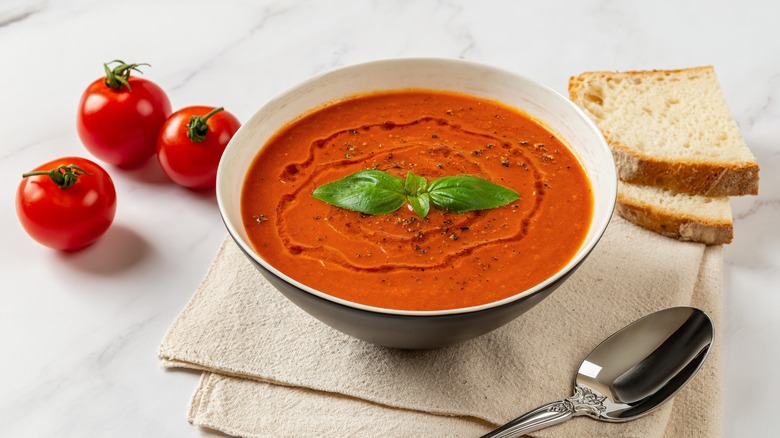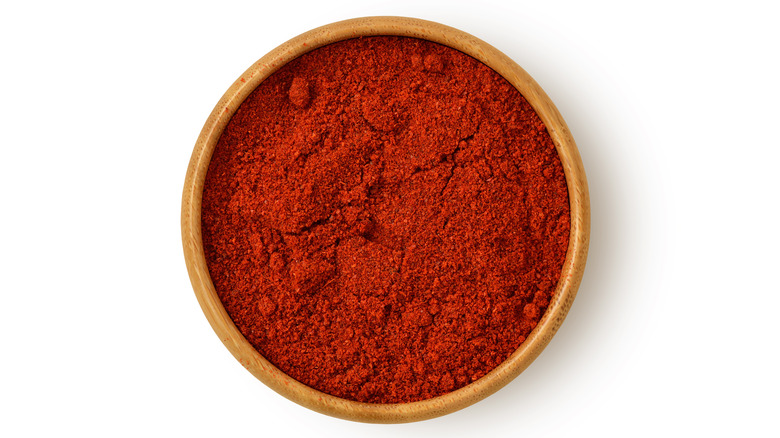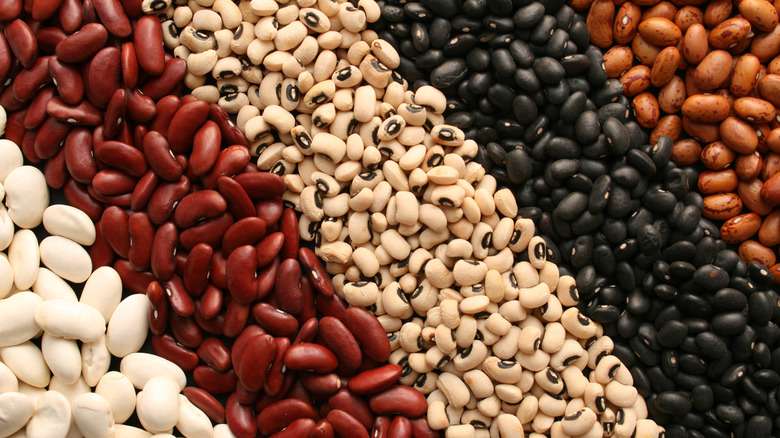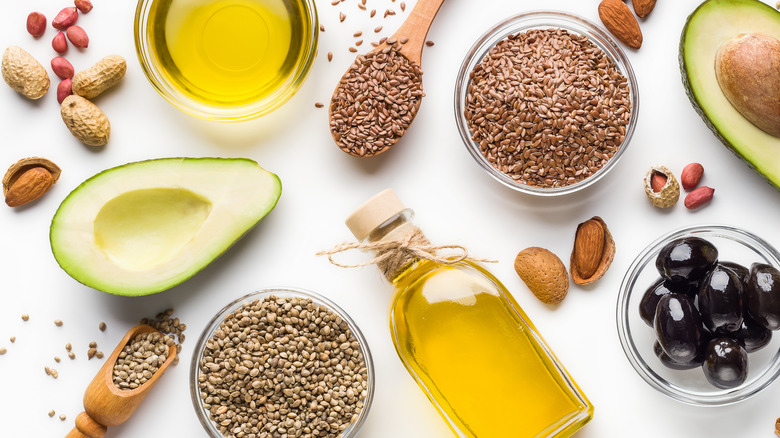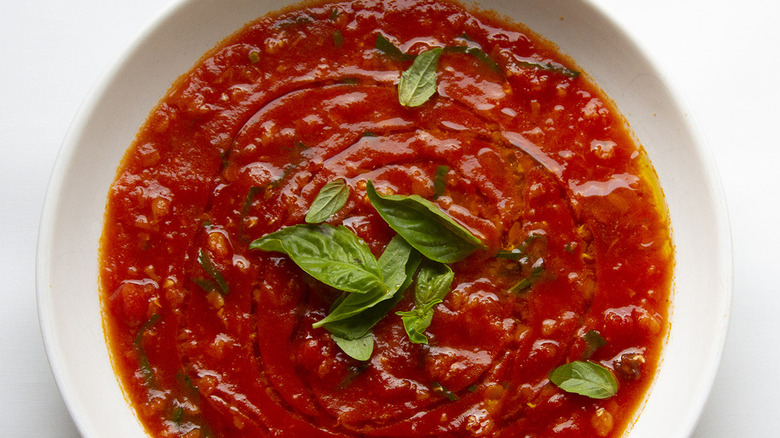6 Tips For Satisfying Vegan & Gluten-Free Soup From Seattle's Caroline Wright - Exclusive
Soup exists in just about every culture, community, and cuisine. There is just something intrinsically healing and nourishing woven into the process of making and eating it, too. Cookbook author, cancer survivor, and Seattle's resident soup cook, Caroline Wright, believes something special comes not just from the soup but also from the act of giving and receiving soup.
She should know more than anyone, too. Wright's re-birth story came at the hands of receiving homemade soup from her local community while she was going through cancer treatment. As an act of reciprocity and self-discovery, Wright returned the favor, making soups to feed those who fed her and her young family during such a tumultuous time. She said to us in an interview, "Making soup and giving it away to people that you love [or] someone having a bad day — it like it changes the person and it changes you. And I think that's the best place to start."
Having just published her second soup-based cookbook, "Seconds," which, like her first book, focuses on vegan and gluten-free soup recipes, Wright encourages everyone to get in the kitchen and make something soupy. Here are a few of her tips and tricks for how to cook your way to a delicious and satisfying vegan, gluten-free soup. For the full scope of Wright's vegan, gluten-free soups, her new book, "Seconds," is available through Seattle-based bookshop Book Larder and is available for national and international shipping.
Use nutritional yeast
"The secret ingredient I will say that is like super helpful for both books and for my relationship to vegan soup has been nutritional yeast," says Wright. Especially for cooks and soups that don't make stock or broth first, nutritional yeast can do a lot of heavy lifting in boosting flavor.
Nutritional yeast is also rich in vitamins and minerals, including B12, which can be difficult to source from a plant-based diet. It's also a vegan protein source, too. Made from inactive yeast known as Saccharomyces cerevisiae, the yeast is fed sugar cane or beet molasses to encourage fermenting before it dries and flakes. The resulting product has become an increasingly popular alternative for those looking for an umami-packed, nutty, cheesy flavor from a plant-based source.
Make sure to stock up on nutritional yeast before digging into Wright's latest cookbook, "Seconds." It's a frequently used seasoning, present in hearty soups from her Hungarian shepherd stew to Mushroom and wild rice soup or French onion.
Try smoked paprika
Having a jar of smoked paprika on hand in your spice cupboard can be a real game changer for adding that deep, smoky flavor reminiscent of a good barbecue. Wright says, "In terms of flavor, I really love smoked paprika because I feel like smoky flavor tends to be hard to achieve from vegetables."
Standard paprika, used in various cuisines, including North African, Spanish, and Hungarian dishes, is typically made from red bell peppers. The peppers are dried, then crushed into a deep red-orange colored powder and added to a number of dishes. Smoked paprika is made using the same peppers, which are dried over a wood fire, adding a smoky, fruity flavor to the spice. The smoke is retained in the pepper's natural oils to create an intensely earthy flavor, which adds depth to any dish. Depending on the spice's country of origin, smoked paprika can also bring some heat or additional sweetness to a dish.
In Wright's new book "Seconds," smoked paprika comes into play a number of times; it pairs incredibly well with beans, including black beans, one of Wright's self-professed favorites. You'll want a jar on hand when making her recipe for Baja veggie chili, Carrot, and za'atar soup, or Escudella verde.
Add beans
"My love for beans has become even greater. Like, I had appreciated them before, but now I really worship them," says Wright. When sourcing a filling, plant-based protein for soup, we all should worship at the legume altar. "Seconds" is no exception. Wright unpacks some of the bean-based research with a detailed bean glossary in the book's first few pages, helping soup cooks know their navy beans from their pintos and split peas from lentils. This handy guide also includes practical suggestions, from whether or not to soak the beans or other pulses used and how to identify the beans by shape, size, and color to simple swaps depending on what each cook has on hand in their pantry.
While the recipes from the book include dried beans, recipe testers also remind readers that should they forget to soak beans overnight, having an Instant Pot can be a lifesaver when cooking. Each recipe includes stovetop directions and an Instant Pot variation to help ensure one way or another, homemade soup is always possible.
Don't skimp on healthy fats
Especially when it comes to vegan soups, which intentionally leave out animal-based sauces of fat, which are often prevalent, including butter, meat, or dairy, fat is vital for many reasons. Healthy fats, especially paired with ingredients like beans, which have relatively no fat at all, are essential in creating a rich, smooth, satisfying bowl of soup. Whether using olive oil, avocado oil, tahini, or coconut milk, fats are necessary in most vegan-based soups.
Wright wholeheartedly agrees. She says, "My black bean soup has a cup of olive oil in it, so it's very dramatic." Wright explains, however, that especially when it comes to vegan-based soups made with water, rather than stock, fat is essential. "Oil is great for beans too, because it trends it transforms the like more mealy, drier flavors to make it smoother and silkier."
Wright also explains how healthy fats should be embraced rather than feared. Healthy fats were a substantial part of her recovery from brain cancer as during her recovery process she was often prescribed olive oil as part of her treatment.
Skip the broth
In her book, Wright writes, "Water is abundant in your kitchen and requires no prep; it allows vegetables to speak for themselves' it is an actual source of life. Stock is none of these things."
During our interview, she made abundantly clear how anti-stock-making she is. During her first soup-based cookbook, "Soup Club," based on her experience making soup for others, Wright quickly realized the amount of extra work and washing up that came from making your own stock before making the soup itself. "I was like, 'This is stupid. Why am I making soup in order to make soup? That just doesn't make sense.'"
Not only was it extra work, but Wright also felt it masked the flavors of the vegetables she was working so hard to create. Instead, she did away with the stock or broth-making process altogether, creating water-based soup recipes that simultaneously made the bulk of the soup and its broth. She notes in the book, under her list of soup-based "commandments," that "stock deserves to be made: after making soup from the vegetable trimmings maybe, but not before. Life is too short." Some recipes, like the tomato basil, begin by making a puree to add water to, but never a separate stock itself.
Try a splash of vinegar
Wright's sixth soup-related commandment in her book "Seconds" involves how to best finish your soup before serving. She writes, "A dash of vinegar stirred in at the end of a soup makes new again the essence of what went into the pot in the first place, only better."
Acidity, as many professional and home cooks will know, is a beautiful secret weapon that can add brightness to almost anything. Whether it's lemon in an oil-based vinaigrette, pickled onions to a meaty taco, or a splash of vinegar added to an earthy bowl of lentil soup, having something on hand to finish will elevate whatever you're making from good to great with just the flick of a wrist, or a squeeze of a juicer.
Beginning with Wright's first recipe, Pasta Fagioli, she suggests adding a splash of cider vinegar alongside a pinch of salt to the end of the cooking. This advice rings true throughout many of the 80 recipes contained in the newly released book. Regarding vinegar, Wright tends to favor cider, with lemon or lime juice also making a frequent appearance as a finishing touch to her dishes.
